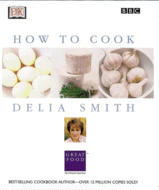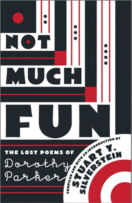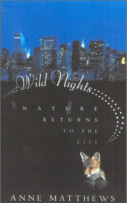Nonfiction Book Reviews
How to Cook by Delia Smith, Miki Duisterhof, Photographer
DK Books, June, 2001.Hardcover, 496 pages.
ISBN: 0789471868.
Ordering information:
Amazon.com
 In these days of stressed-out working moms and
high tech burnout, it's no wonder that dinner for the
average child usually ends up being a McDonald's Happy Meal.
In fact, we've become so rushed as a society that some
think that the home cook is about to go the way of the
dinosaur. But British chef Delia Smith asserts that it
really doesn't take that much time to prepare a healthful
and delicious home made meal, and her latest book
backs up her proposition quite firmly. How to Cook
is a combination of two separate volumes originally
published in the UK. In Book One she starts with the
basics, giving detailed explanations of the staples of
all cooking: eggs, flour, potatoes, rice and pasta.
Book Two continues with the preparation of
fish, meat, poultry, fruit,
vegetables, cheeses and chocolate.
In these days of stressed-out working moms and
high tech burnout, it's no wonder that dinner for the
average child usually ends up being a McDonald's Happy Meal.
In fact, we've become so rushed as a society that some
think that the home cook is about to go the way of the
dinosaur. But British chef Delia Smith asserts that it
really doesn't take that much time to prepare a healthful
and delicious home made meal, and her latest book
backs up her proposition quite firmly. How to Cook
is a combination of two separate volumes originally
published in the UK. In Book One she starts with the
basics, giving detailed explanations of the staples of
all cooking: eggs, flour, potatoes, rice and pasta.
Book Two continues with the preparation of
fish, meat, poultry, fruit,
vegetables, cheeses and chocolate.
As always, part of Delia Smith's charm (other than the fact that she is a fantastic chef) lies in her winning personality and ability to relate to her readers. In Chapter 12 "Fish Without Fear" she writes, "Why is it that people are afraid of fish?….I feel my task here is to reassure those of you who are afraid and try to provide a sort of simple introduction to the whole subject of cooking fish, which will hopefully persuade you to try." And try you will, after you see some of Miki Duisterhof's incredible photographs of Roasted Butterflied Shrimp in Garlic Butter and Roasted Salmon Fillets with a Crusted Pecorino and Pesto Topping. And if fish really isn't your thing, you can always dive into Mini Boefs en Croute, Broiled Chicken Kebabs with Gremolata or Toasted Goat Cheese with Blackened Sherry-Vinegar Onions, followed by Melting Chocolate Puddings or A Very Chocolatey Mousse.
The ingredients are listed down the left side of each page for easy reading, and are listed in both American and British measurements. The directions are easy to follow, and Delia peppers the recipes with funny and useful tips and anecdotes. This is an absolutely fantastic cookbook for both novices and advanced cooks alike. Its emphasis on fresh foods, tasty flavors and easy preparation will make it a much-used reference in the kitchen. Highly recommended.
Not Much Fun: The Lost Poems of Dorothy Parker by Stuart Y. Silverstein (Editor)
Scribner, July, 2001.Trade Paperback, 256 pages.
ISBN: 0743211480.
Ordering information:
Amazon.com
 Not Much Fun is actually a great deal of fun to
read, if you happen to enjoy humor and wit. Mr. Silverstein
divides the book into three parts: an introduction that is largely
biographical, footnotes which are mostly anecdotal and
the poems, which are always enjoyable. Skipping any
one of these parts will leave the reader with only two-thirds
of the enjoyment that this book gives on every page.
The reader should be advised, however, not to read the book
on a plane or in a hotel lobby because shaking with silent
laughter and occasionally wiping away tears of mirth will
only result in embarrassment and the puzzled stares of other
travelers. The best place to read Not Much Fun while on vacation
might be at the beach where other people are much more
involved with their own diversions to notice giggles and guffaws.
Not Much Fun is actually a great deal of fun to
read, if you happen to enjoy humor and wit. Mr. Silverstein
divides the book into three parts: an introduction that is largely
biographical, footnotes which are mostly anecdotal and
the poems, which are always enjoyable. Skipping any
one of these parts will leave the reader with only two-thirds
of the enjoyment that this book gives on every page.
The reader should be advised, however, not to read the book
on a plane or in a hotel lobby because shaking with silent
laughter and occasionally wiping away tears of mirth will
only result in embarrassment and the puzzled stares of other
travelers. The best place to read Not Much Fun while on vacation
might be at the beach where other people are much more
involved with their own diversions to notice giggles and guffaws.
Dorothy Parker will always be remembered most for her hilarious yet lethal one-liners which have from time to time entered the general language. The supposed interchange between Dorothy Parker and Clare Boothe Luce when both approached the same door is probably not at all true. It has been given a sort of immortality however, especially by women who love to tease each other with "age before beauty" which is soon followed with the verbal volley of "and pearls before swine." Dorothy Parker is also given credit for having said "men don't make passes at girl's who wear glasses" and "a girl's best friend is her mutter." It is little anecdotes like these that make the footnotes a joyous romp through one liners that can inflict unremitting laughter.
One might ask why the Mr. Silverstein chose the title, Not Much Fun, for a book that is so humorous. The answer can be found in one of the footnotes which recounts Dorothy Parker's answer to a bartender's stock question of "What are you having?" Her quick reply was, "Not much fun!" Sadly, for her, Dorothy Parker's life was full of success in some areas, but failure in many others. She always wanted to write like Edna St. Vincent Millay, but since she had to obtain her entire income from writing, she had little time to pursue the elegant constructions of Ms. Millay. Heavy drinking was a deeply ingrained habit that took its toll through the years, and unhappy romantic liaisons added to her personal unhappiness. Nevertheless, out of her pain and disappointments came a sardonic wit that provided much laughter for her readers. After all, people love most those who cause us to laugh. Not Much Fun is a great deal of fun for those who enjoy a well-written phrase and devastating wit. Mr. Silverstein is an entertaining collector and biographer who is himself a master of the English language at its best.
--Sarah Reaves White
Wild Nights : Nature Returns to the City by Anne Matthews
North Point Press, May, 2001.Hardcover, 207 pages.
ISBN: 0865475601.
Ordering information:
Amazon.com
 One would have thought that the subject of New York
would have been exhausted by now. Books and
articles have chronicled the history, the citizens, the
architecture, the literature and the influence of the city
from all different viewpoints. Yet Ms. Mathews has come
up with a unique view of the city and its future from her
study of its relationship to wildlife and of wildlife's relation
to the city. For those who think that only pigeons and rats
are really adapted to life in the city this book will be a revelation.
One would have thought that the subject of New York
would have been exhausted by now. Books and
articles have chronicled the history, the citizens, the
architecture, the literature and the influence of the city
from all different viewpoints. Yet Ms. Mathews has come
up with a unique view of the city and its future from her
study of its relationship to wildlife and of wildlife's relation
to the city. For those who think that only pigeons and rats
are really adapted to life in the city this book will be a revelation.
Many a suburbanite and some city dwellers have been startled on their early morning jogs at seeing a coyote trotting down a street as if it were in its natural habitat. On occasion, homeowners have been surprised to see a huge hawk devouring the remnants of a squirrel it had clearly killed. Grandparents have discovered that raccoons had savaged the grandchildren's wading pool overnight or had decided on winter quarters in the attic. The deer in some exclusive neighborhoods have dined on thousands of dollars worth of landscaping, and hapless small pets have become meals for nameless predators. Yet most of us feel that these are isolated incidents, sometimes entertaining and sometimes upsetting. If a young jogger is attacked on her early morning run near a posh California development, it is dismissed as a rare tragedy that probably will not be repeated. Nothing could be further from the truth. Developers are invading ancient habitats of predators. We don't expect this sort of thing to be happening in Manhattan, but actually some of this is occurring right outside our doors.
Wild Nights is divided into a compelling and not-to-be-skipped introduction, "Sky and Water," "Leaf and Stone" and "Day and Night." The section entitled "Leaf and Stone" is very alarming as it recounts the almost weekly dangerous encounters that both city dwellers and suburbanites are experiencing. The main difficulty is that urbanized people no longer understand the habits of wild creatures. Parents of young children, as well as pet owners and early morning joggers, are becoming increasingly aware that there is more to fear than muggers in the early dawn or at dusk or after dark. Encounters can be shocking for city dwellers, but wildlife is adapting to the change in their environments with a loss of fear and an appetite for the easy life that is increasing. It may be amusing to hear tales of the Canadian Geese who no longer care to commute on long boring trips to the winter breeding ground, but what do we do when the memory of how to migrate is not ingrained into the brains of succeeding generations? What will happen when large predators no longer fear Man, but rather have decided to immigrate and enjoy a carefree lifestyle?
It almost seems that while we are watching documentaries that we are not considering what we are seeing. Ancient civilizations in Central America have been taken back by their environments. Wildlife is only cute, endearing and cuddly for about the first three months of life if for that long. Kittens grow up to be cats, but bear cubs grow up to become unpredictable and dangerous bears. As always, knowledge is the best weapon of our species. Ms. Matthews' well-written book imparts that knowledge and should help raise the consciousness about the effect that modern civilization is having on the wildlife that it has displaced. Inhabitants of the New York area are not the only persons who should become familiar with the in-depth and fascinating study that Ms. Matthews has presented to us. Wildlife is still here, and we all need to know more about it.
--Sarah Reaves White
Return to Book Reviews Index
More from Writers Write
Stephen King Quotes
quotes from the master
quotes from the master
Grammar Tips
improve your writing
improve your writing
Writing Prompts
spark your creativity
spark your creativity
